C&S Locomotive 44: A Photo Study
C&S Locomotive 44: A Photo Study
|
This post was updated on .
Happy President's Day!
A few weeks ago, in John Greenly's "Arc" headlight thread (http://c-sng-discussion-forum.41377.n7.nabble.com/arc-headlights-and-dynamos-td15165.html), I posted a c.1901 photo that I copied from an eBay vendor's ad, a head end view of C&S 44 in Clear Creek Canyon. The photo turned out to be stunning when enlarged, so I went to eBay and purchased a print without the overlying eBay scan notice, to post here. The same vendor had another photo of C&S 44 taken a few years later, so I purchased that one as well. While awaiting the prints' arrival from Canada, I wondered if there were any other first decade photos of 44. I was surprised to find many, making number 44 perhaps the most photographed of all the Cooke 2-8-0's. So I've posted them here, in chronological order: C&S locomotive 44 was built by Cooke in 1883, about the time the UP absorbed the South Park into the UP system. Originally numbered DSP&P 48 on delivery, after the 1885 UP renumbering she bore the number 205 on both the DSP&P and the DL&G after the receivership. This is the only photo of 205 that I've found, from the late 1880s:  In "Black Cut" near Rocky Point, above Breckenridge. In Ferrell's The South Park Line The new C&S was formed at the end of 1898 and all the UPD&G and DL&G locomotives were renumbered into the new system's scheme. I've found no photos of 205 / 44 from 1898-99, but she probably looked like her sister locomotive number 203: 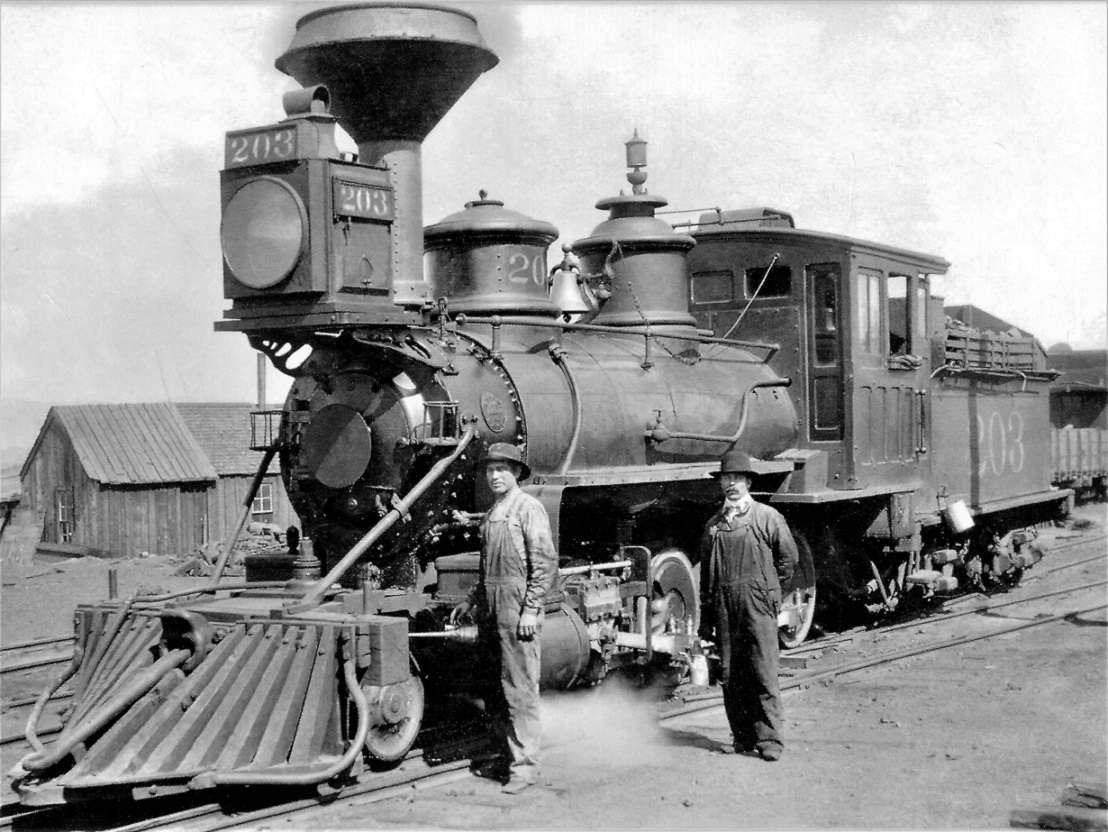 Como, in Ferrell's The South Park Line, back of dust jacket. By 1901-1902, C&S 44 seems to have had a major shopping and was assigned to the Clear Creek line for most of her remaining career. This is the photo that I purchased: 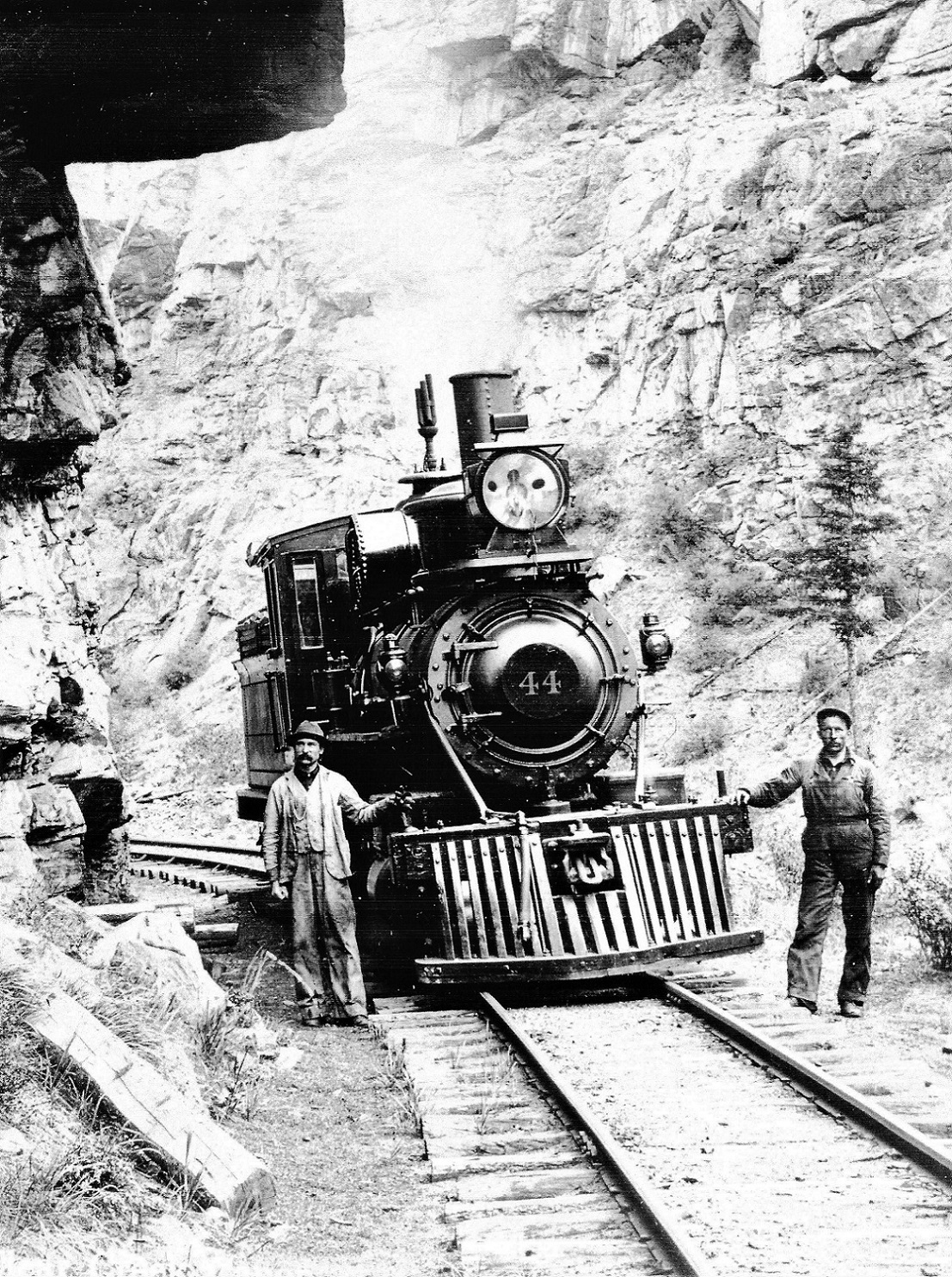 Clear Creek Canon, at Hanging Rock, c.1901-1902. Now in Courtney Collection. Another photo from about the same time period was taken at the Hidden Treasure mine in Idaho Springs, and gives some interesting cab and tender detail: 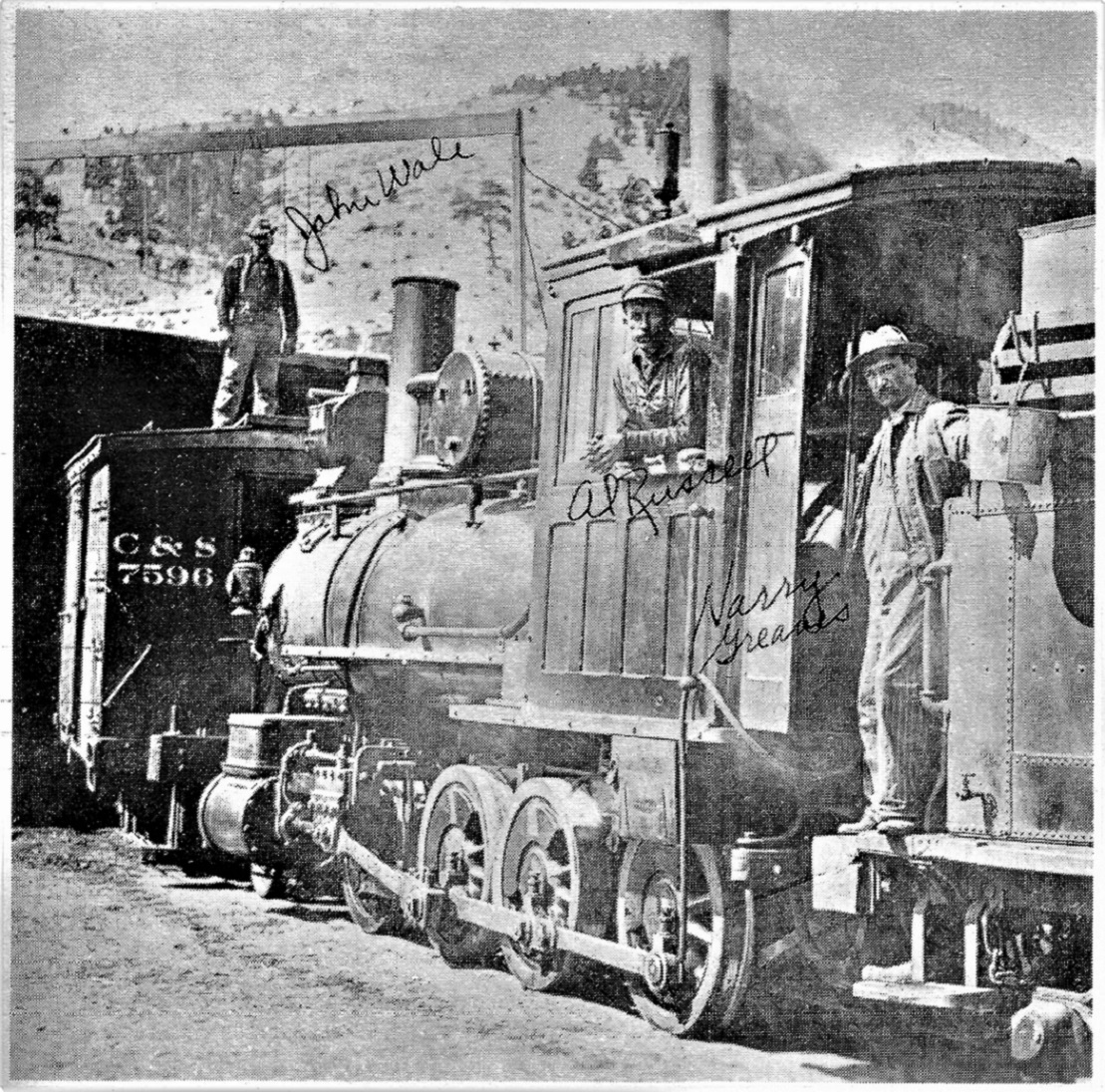 G.E. Lundberg collection, in Colorado Rail Annual 10 I can't prove that this is number 44 on this Clear Creek freight train c.1901-1903, but given the territory assigned to C&S 44, it may well be: 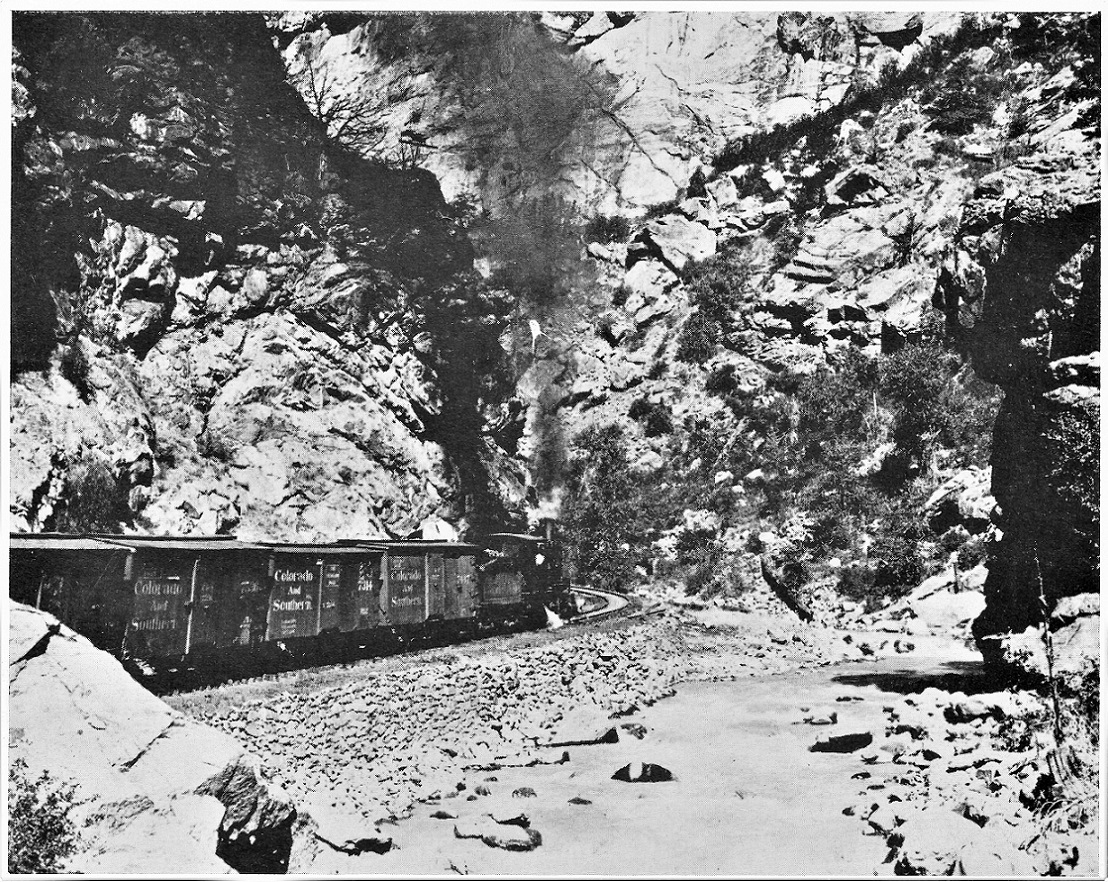 Library of Congress, in Colorado Rail Annual 10 The other photo of C&S 44 that I purchased is this portrait at Denver Union Station, taken sometime between 1903 (automatic couplers mandated) and 1906 (new C&S lettering scheme introduced).  Now in Courtney Collection; also published in Narrow Gauge Pictorial VI In the fall of 1910, C&S 44 was photographed working the Pennsylvania / Iron City mill, below Blackhawk. She has had her cab steel sheathed and wears the new C&S lettering scheme: 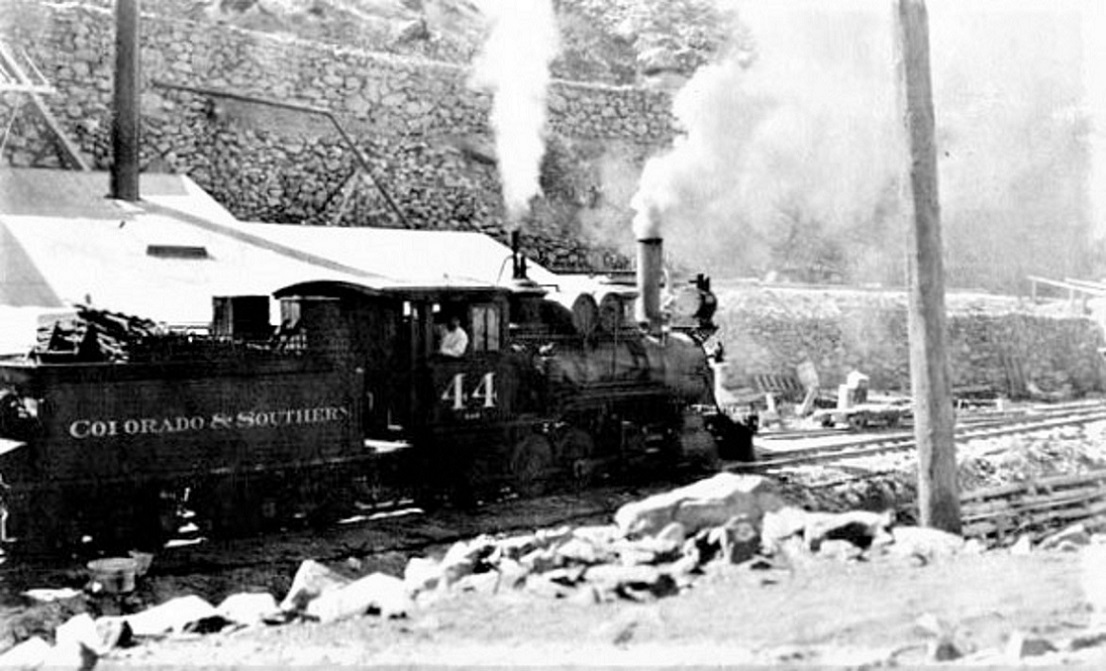 http://gilpintram.com/images/Photo-1999.1022.046.jpg Another view from the same place, on the same day, shows her tender in better detail; a brand new SUF boxcar is also shown: 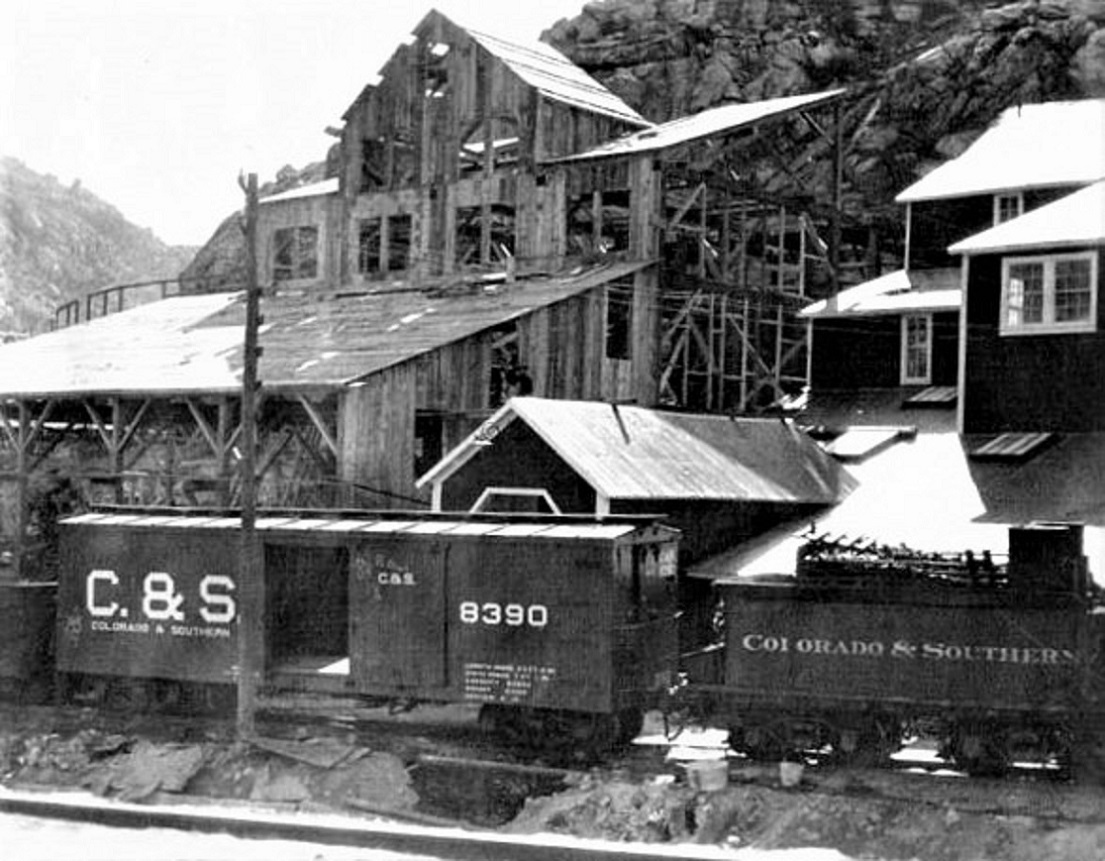 http://gilpintram.com/images/Photo-1999.1022.026.jpg As her working career was nearing its end, C&S 44 was photographed in lower Platte Canon, on a work train, delivering stuff for the water works construction on April 26, 1912: 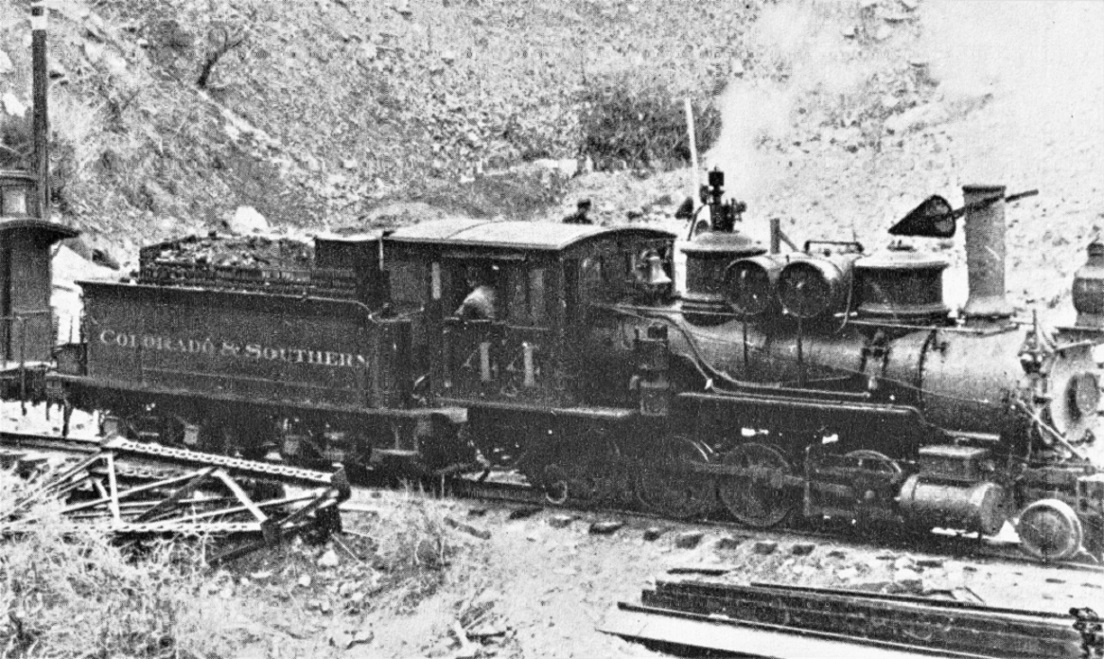 Ronfor Collection in Narrow Gauge Pictorial VI My reading suggests that C&S 44 was not one of the Cooke 2-8-0's stored in the Como roundhouse wood addition. She was listed as scrapped in October of 1914, so probably spent all of her C&S career working out of Denver, primarily on Clear Creek. I find the visual chronology of C&S 44 fascinating, as little physical changes occurred between the late 1880's and the birth of the C&S, but from 1900 to 1912, each photo shows subtle changes in the appliances of the locomotive, as the locomotive technology evolved on the C&S. Can you name them?? 
Jim Courtney
Poulsbo, WA |
Re: C&S Locomotive 44: A Photo Study
|
Nice job Jim, good to see this here.
UpSideDownC
in New Zealand |
|
In reply to this post by Jim Courtney
Jim,
Differences, from first look-Headlight, stacks, air tanks, bell for starters. Any more? Paul R. |
Re: C&S Locomotive 44: A Photo Study
|
This post was updated on .
In reply to this post by Jim Courtney
Jim, this is great!
I'm looking at the relation between smokebox extension, smokebox front replacement, and stacks. interesting story in these photos. In looking over various photo evidence I had come up with a typical timeline for South Park/C&S engines in which the smokebox was extended when the switch to straight stack was made somewhere around the turn of the century, and that was also when the original smokebox front was replaced with the standard C&S version. And all this went with the reworking of the smokebox innards, though we can't see that. But first of all, I had already noticed at least one exception, and you have shown it: the Pictorial Supplement photo of 203 shows the smokebox front has been replaced while the smokebox is still short and carrying a McConnell stack. And, contrariwise, now I see that #44 still had its original smokebox front after the smokebox had been extended and the unique riveted straight stack installed (in the Hidden Treasure mine photo the smokebox is definitely extended, in the Hanging Rock photo I couldn't tell for sure, it's too head-on). And then a couple of years later the smokebox front has been replaced (Denver photo), and even later, finally the riveted stack was replaced with the standard C&S shotgun. By the way, after I noticed the odd riveted straight stack when you posted the Hanging Rock photo of #44 in the other thread, I searched and so far have come up empty- this could be the only engine to have had such a stack. That's a beautiful print, the Hanging Rock photo- thanks for getting it for us!! John
John Greenly
Lansing, NY |
|
In reply to this post by Jim Courtney
Jim,
Thanks. The #44 is one of my favorites. It can be seen in the pictures and is mentioned in Coleman's pictorial that the #44 was one of the few B4Bs that received a single-piece smokebox rather than the riveted extension that most of the others did when the smokeboxes were lengthened. The #55 is the only other one I know of. Does anyone know why, when the B4Bs got their extended smokeboxes, the #44 received a full one piece and most of the others got a riveted ring addition? Skip Egdorf Los Alamos, NM
Skip Egdorf
|
Re: C&S Locomotive 44: A Photo Study
|
I can only surmise that the Smokebox was that far gone and needed to be renewed at the same time the extensions were being fitted unless it was under repair from an accident or derailment.
UpSideDownC
in New Zealand |
Re: C&S Locomotive 44: A Photo Study
|
This post was updated on .
In reply to this post by John Greenly
Yep, lots of fascinating details . . .
As to the stacks, I think there are three versions of the "shotgun" stack, see if ya'll agree. The stack on Hanging Rock 44 and Idaho Springs 44 has a row of vertical rivets, front and back, suggesting that it is formed of rolled sheet metal, two-halves riveted together. The stack is straight its entire length, from stack base/saddle to the cap. The stack on Denver 44 c 1905 has no rivets, suggesting a cast stack that has been machined. But it is also straight its entire length, from stack base/saddle to the cap. The stack on 44 in 1912 is different than the other two. It also appears to be cast, but just above its attachment to the base/saddle it narrows acutely then tapers gradually about half way up the remaining length, then is straight, of constant diameter, to the cap. I don't know what to call it, perhaps a "puckered tapered stack"? This type of stack was retained when the Ridgeway arrestors were adopted about 1918. ____________________________ As to the smoke box front, no doubt Hanging Rock 44 still has its original Cooke smoke box front, but notice how the door hinges are located on the engineer's side of the front, while Denver 1905 number 44 has had the smoke box front extended and the door restrained by the little C-shaped clamps or dogs, the hinges now on the fireman's side, opposite that of the TOC view of Cooke 203. I've always wondered what these smoke box front extensions are all about; what was their purpose? We think of them as a signature C&S feature, but they actually show up in the 1890s, during the DL&G receivership: 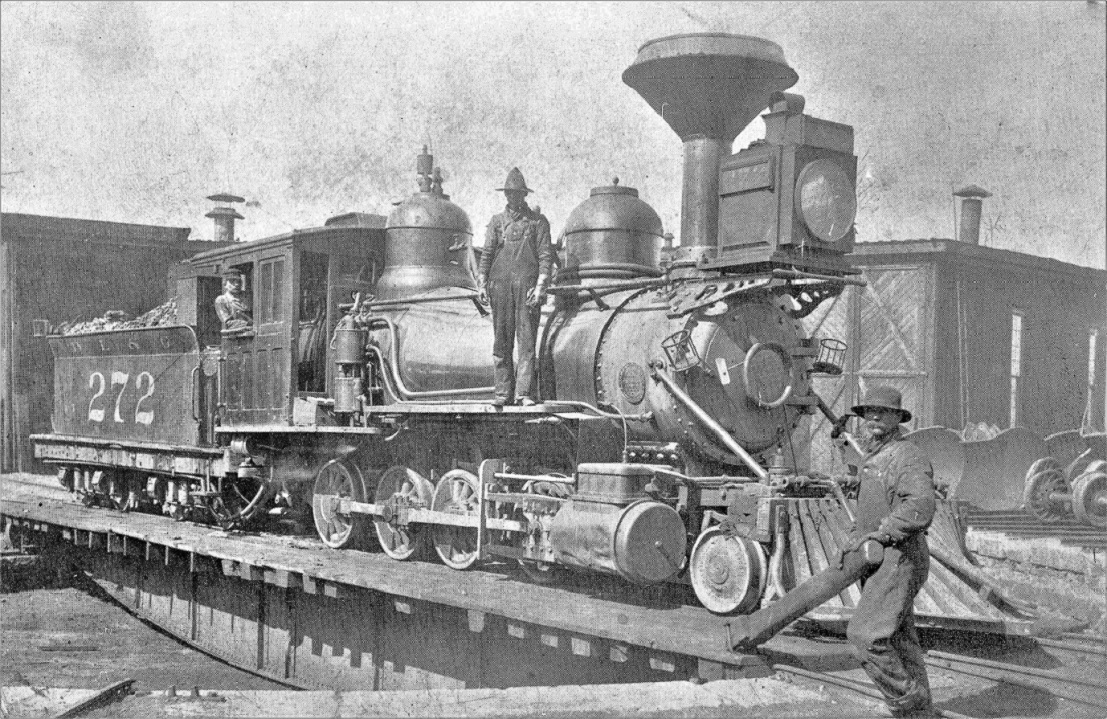 Como, 1898?. DL&G 272, later C&S 69 had an extended smoke box front in the late 1890's, but the door was restrained by 6 stay bolts on washers, instead of the later C-clamps. Even after the smoke box was extended and a "puckered tapered" stack installed, the older extended front/door was retained:  Dickey, 1903. I want to convert two of my Overland B4-Ds to c.1900-1901 models of numbers 68 and 66, as in this double header at Parlins: 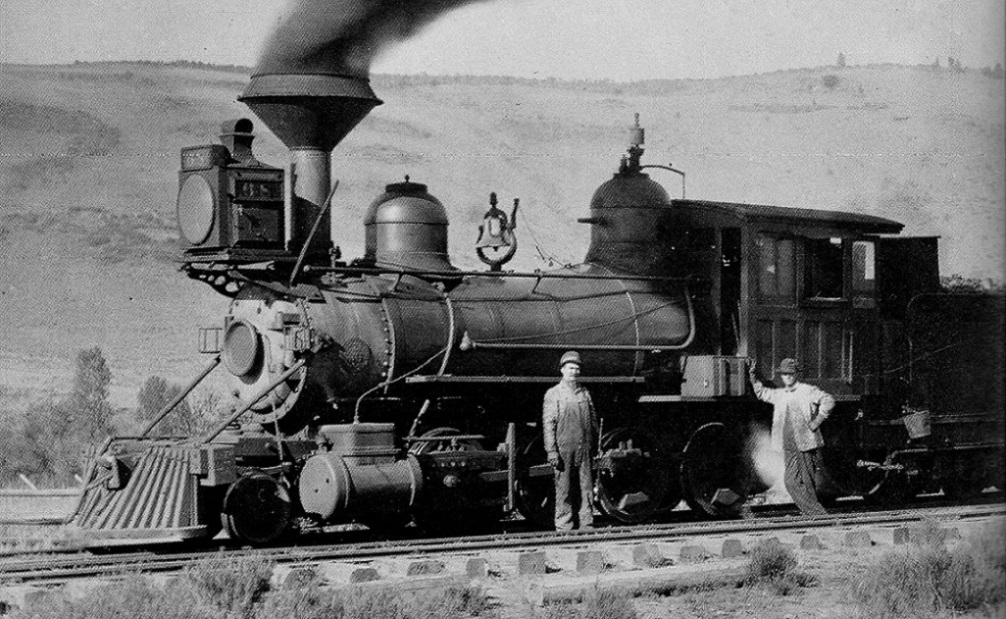  Both locomotives have the extended smoke box front with stay bolts. Note the door hinges on different sides of the two locomotives. I've never seen a builder's photo of the 1890 Baldwins that would become C&S 63-70; perhaps they were built with the smoke box front extension? And this gives me a chance to derail my own thread. Since I needed this early version of the extended smoke box front, and it is not available as a brass casting, I sent this drawing (that I believe Todd Hacket posted) to our own Keith Hayes. 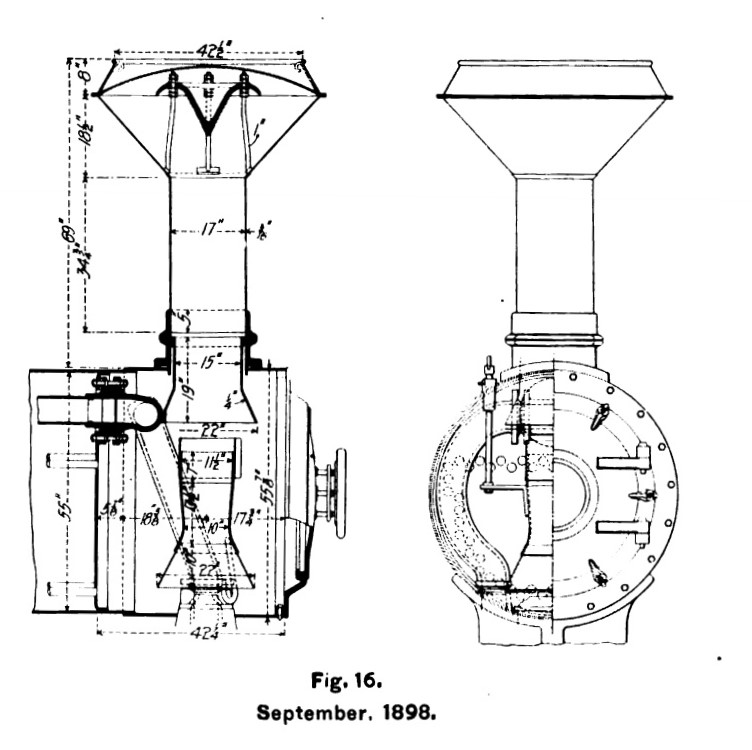 I also gave Keith the actual inside and outside diameters of the Overland smoke box fronts that I had cut back to their original short length. Keith kindly agreed to make CAD drawings on SketchUp: 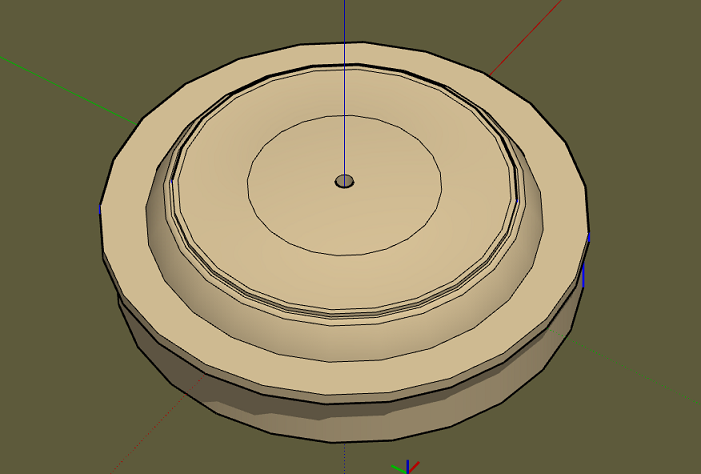 To avoid printing flaws we decided to omit the circumference rivets and the six stay bolts. 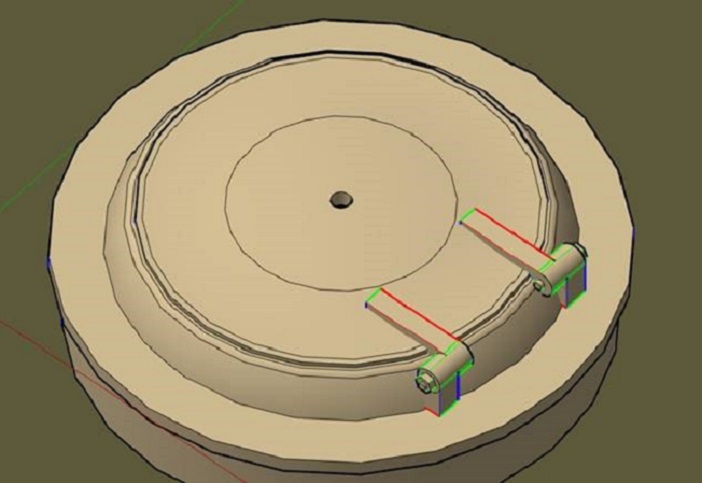 Keith sent the drawings to Shapeways and set the part up for printing in brass: https://www.shapeways.com/product/4VM6KSBNN/c-s-cast-smokebox-1-64?optionId=144613345&li=marketplace  The printed brass part fits perfectly in the Overland smoke box:  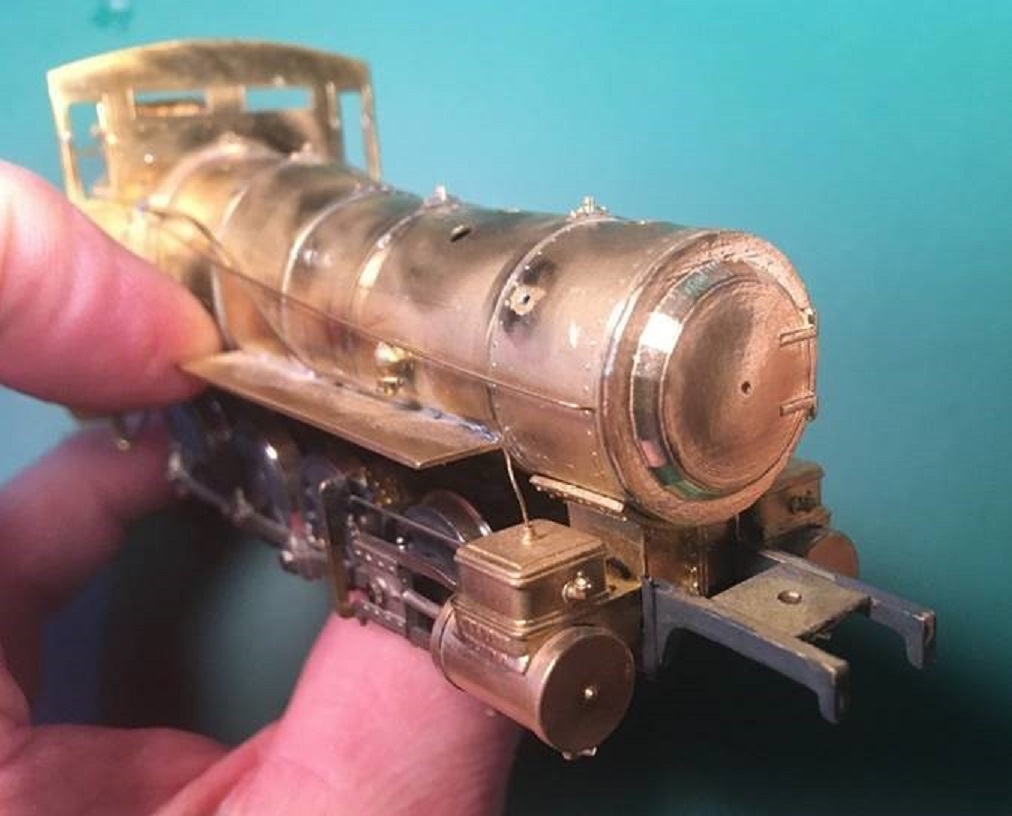 I have an order for Tichey rivets and square bolt heads on washers coming; I will probably make a styrene drilling jig to drill holes for the parts. A huge round of applause to Keith Hayes!     
Jim Courtney
Poulsbo, WA |
Re: C&S Locomotive 44: A Photo Study
|
This post was updated on .
Jim,
Yes, you're certainly right about the stacks. I forgot about the rivet-less second version in that one photo. I believe that both the riveted version and the second version use the same bottom end fitting as the McConnell stacks, that's the collar that bolts the stack to the base on the smokebox. And in fact that base never changed on any engine, as far as I can tell. How about we just call the third stack, the one with the flare at the bottom, the C&S standard shotgun stack- it's the one that appeared universally. I believe the flare served to bring the bottom end of the stack up to the right ddiameter to mate with that same old base. I still have not found any photo of an engine other than 44 with either the riveted or rivet-less straight stack with the unflared bottom and old-type mounting collar. As to the smoke box extension, this always goes with the change from McConnell to shotgun stack, and I'll bet that the interior configuration of the smokebox was redesigned to couple properly to that smaller diameter stack. The intent of the design was to divert cinders from the exhaust to stay in the smokebox before they went up the stack, as opposed to the earlier stacks where cinders were diverted up in the big stack tops. The extended smokebox length was to accommodate the desired gas flow and also to provide more volume for cinders to accumulate in. This was of course not unique to C&S, other RRs did something similar at the end of the giant stack era. The smaller diameter, often double-tapered venturi stack and associated features were designed to speed up and increase the efficiency of gas flow through the engine, compared with the slow flow through the earlier large stacks. Of course, with the coal the C&S used this design turned out to be unsatisfactory, hence the stopgap measure of the "Como" cone hat, as well as the odd "diamond stacks of 1910", followed by the Ridgeway final solution. What you're calling the extended smokebox front, that Keith has so nicely produced for you (bravo!!), I've been calling just the standard C&S smokebox front, since it became pretty much universal, with minor variations, on all engines after 1905 or so, certainly by 1910. I also wonder whether it was original to the B4D's. I've found no early photo of any of them with a different front. Why did the C&S standardize on this front? Maybe some simple practical reasons, like big door with good, quick access into the smokebox, good strength and longevity, easy to maintain, standardization meant no searching through lots of different replacement parts, etc.?? That bulged shape would be very strong and resistant to warping and sealing problems. I'm very glad you started this thread, these questions have had me wondering for a long time, hope to have others' feedback about all this!! John John
John Greenly
Lansing, NY |
Re: C&S Locomotive 44: A Photo Study
|
Hi John,
If you examine photos of C&S locomotives you will see that the smokebox fronts, doors and keepers varied greatly over the years and from locomotive to locomotive. Since my favorite is C&S 71, you can see in the early photos that it had a six dog front with the arched keepers. I wish that I could say with confidence that this was a UP design or a Baldwin design, but I can't. I notice that the drawing for the McConnell stack has the six keepers. Sometime after 1926 the 71 lost this smokebox front for a door that used 16 (?) of the smaller dogs to keep the door shut. I will bet that the fireman who had to clean cinders out of the smokebox loved this change. This change of doors seemed odd to me because it looks like 72 and 73 kept their six dog fronts to the end of their careers. That is until I read that 71 was in a head on collision South of Denver with a passenger train. According to the newspapers, it wasn't "Serious" (as in no lives were lost) but it was serious enough that the 71 needed a new smokebox door. If you look at 60 in Idaho Springs the smokebox door has 4 keepers (or dogs) on it. On some of the earlier C&S locomotives there were no keepers at all just long bolts (or nuts) that kept the doors closed. I can imagine that with the constant opening for cleaning that the threads got pretty messed up. I also see that the class mentioned also had a door design with 8 of the dogs. Maybe if you are modeling you either (a) Keep adding them until you get tired of it or (b) just glue or solder on bolt heads.... We never did go to the European style of wheel closure in this country which would seem to be much easier as far as manpower and less expensive as far as time paid to open. Rick |
Re: C&S Locomotive 44: Stacks and Extended Smoke Box Fronts
|
In reply to this post by John Greenly
John's association of the smoke box front extensions with the McConnell stack era (1898-1901) and the early straight stacks piqued my OCD curiosity.
When were the earliest examples of the smoke box front extensions? The Baldwin 2-8-0's that became C&S 63-70 were built in 1890, and photos from the early 1890's show them in place with the six stay bolts securing the door, well before the McConnell stack era:  DL&G 269, later C&S 66, in Kindig, et al., The Pictorial Supplement . . . 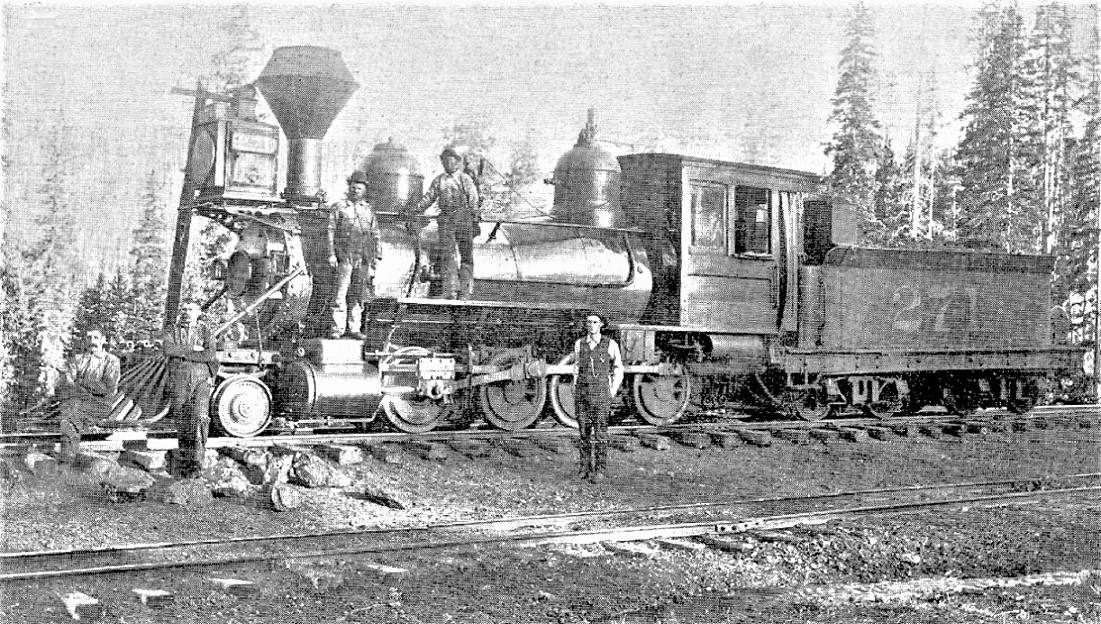 DL&G 271, later C&S 68, in Kindig, et al., The Pictorial Supplement . . .  DL&G 271, later C&S 68, at Rocky Point, in Ferrell's The South Park Line The 1890 Bladwins may have come from the builder with this feature. Cooke locomotive 204, later C&S 43, was photographed at Morrison in 1893, with a DSP&P style diamond stack, and has the extension to the smoke box front, door secured by six of the C-shaped clamps, keepers, dogs or whatever . . .  And then there is this: The six Rhode Island 2-8-0's that became C&S 57-62 were built for the UP subsidiary Utah and Northern in the spring of 1886. In 1888 they were transferred to the South Park division, as the U&N was being standard gauged. The DL&G purchased them outright in 1890, retaining their original 1885 UP numbers 260-265. As built, the Rhode Islands had a very long extended smoke box, a conventional smoke box front and straight stacks:  U&N 265, later C&S 62, in Ferrell's The South Park Line But sometime after their arrival in Denver, the South Park shop forces applied a DSP&P style diamond stack, replaced the extended smoke box with a conventional (for the time) short smoke box, and added a smoke box front with an extension of smaller diameter than on the Baldwins, the door secured by four of the C-shaped clamps, the same feature that survives on C&S 60 to this day:  U&N 261, later C&S 58, at Wheeler, in Colorado Rail Annual 10. The Wheeler photo has a DSP&P Tiffany reefer in the train, not yet re-lettered to the standard UP scheme, so the photo could predate 1890 and the arrival of the Baldwins. So, to me, the question remains, was the smoke box front with extension of the door a Baldwin design that arrived with the 1890 2-8-0's, that was liked by the South Park and copied on the other locomotive classes? Or was the smoke box front with extended door a UP design, specified in the Baldwin order? The extended smoke box front with door secured by bolts only seems to appear on the Baldwins of 1890. When applied to other classes, the door on the extension is secured with the C-shaped clamps of varying numbers. Anyone else have any thoughts?
Jim Courtney
Poulsbo, WA |
Re: C&S Locomotive 44: A Photo Study
|
In reply to this post by Rick Steele
Hi Rick,
thanks! yes, 60 and 71 were two of the exceptions to my over-generalization about smokebox front standardization. I've also often wondered why US railroads never adopted the neat smokebox door mechanisms so common in other countries. I remember once when visiting the RH&DR on the English Channel coast I watched the engine driver of one of my great uncle Henry's 15" gauge Pacifics open the smokebox with the two clock-hand-like lever mechanism used by British locomotives. Piece of cake, done in no time. Of course a full-sized one would be a bit more of a task, but still very quick compared with the many dog or clamp closures on US locos. The C&S ones, with only 6, were at the simple end of the scale in that sense! Cheers, John
John Greenly
Lansing, NY |
Re: C&S Locomotive 44: Stacks and Extended Smoke Box Fronts
|
This post was updated on .
In reply to this post by Jim Courtney
Jim,
thanks, these are great illustrations of more of the early smokebox front story. Yes, I'm with you and Rick in thinking that the extended fronts secured by bolts were likely supplied originally on the Baldwins, either their design or one specified by the UP. I'm inclined to say that it may have been a UP spec, because I've not found any photos of Baldwin engines on other roads with this smokebox front. Anyway, it must have worked well, apart from the bolts, and with the change to the C-dogs a similar design spread to other C&S classes over time, sometimes on the short smokeboxes, and more nearly universally on the later extended boxes. So, I agree with all your thoughts. Wow, yes, I had forgotten how huge the original Rhode Island smokeboxes were. Some Schenectady and Baldwin smokeboxes in the early days of straight stacks were almost as long. Some Baldwin 2-8-0's built for the F&CC originally had 5'8" long smokeboxes, about the same as the Rhode Islands. I wonder what was going on inside there? Room for lots and lots of cinders, for sure! John
John Greenly
Lansing, NY |
Re: C&S Locomotive 44: A Photo Study
|
In reply to this post by Jim Courtney
Hello!
Can someone tell me what the partially hidden board and batten building is behind the front of Engine 203 in Como (photo #2)? I was hoping that it was the sandhouse at the end of the coal chute because I've never seen a good view of the side but I'm not so sure. Maybe it's the car shop or just something else. Nevertheless an interesting building with the two different roofs. Kevin Fall Moodus, CT |
Re: C&S Locomotive 44: A Photo Study
|
Kevin,
the Carshop of Pat Gibbony https://digital.denverlibrary.org/digital/collection/p15330coll22/id/5149
UpSideDownC
in New Zealand |
Re: C&S Locomotive 44: A Photo Study
|
Chris,
The earlier photo of the carshop is much less run down which threw me off a little. Thanks, Kevin |
Re: C&S Locomotive 44: A Photo Study
|
Administrator
|
In reply to this post by Rick Steele
Rick, that flat front on #71 matches those on #9, #70, #74, and #537.
I've always thought it curious that one engine each of the B-3-C, B-4-D, B-4-E, and B-4-F classes received one. It's also odd that of those four C&S engines, only #70 has not survived. Seems like the Mechanical Dept. kept tinkering with the fleet in later years. |
Re: C&S Locomotive 44: A Photo Study
|
Mike,
I agree that it might have been tinkering as well. Of course it could have been a CB&Q standard sent out from Chicago and implemented in the joint Locomotive Shop in Denver. Another question to ponder. I wonder if a comparison of sized between the small smokebox doors on the Q standard gauge locomotives and the smokebox doors on the smaller boilered C&S 3' gauge locomotives might reveal any details. Something for someone to do in their free time.... I am probably wrong, but it is just speculation as to utilization of existing parts. Rick |
Re: C&S Locomotive 44: A Photo Study
|
Rick,
that's a very good question. I've found one standard gauge data point:  this appears to be a Baldwin engine, certainly looks like the extended smokebox, and do I not see a C-dog clamp highlighted by the sun? Again given that I haven't found Baldwin engines with this front on other roads, it seems more likely that this was a UP specified design. Note also the headlight bracket and stack! John
John Greenly
Lansing, NY |
«
Return to C&Sng Discussion Forum
|
1 view|%1 views
| Free forum by Nabble | Edit this page |

